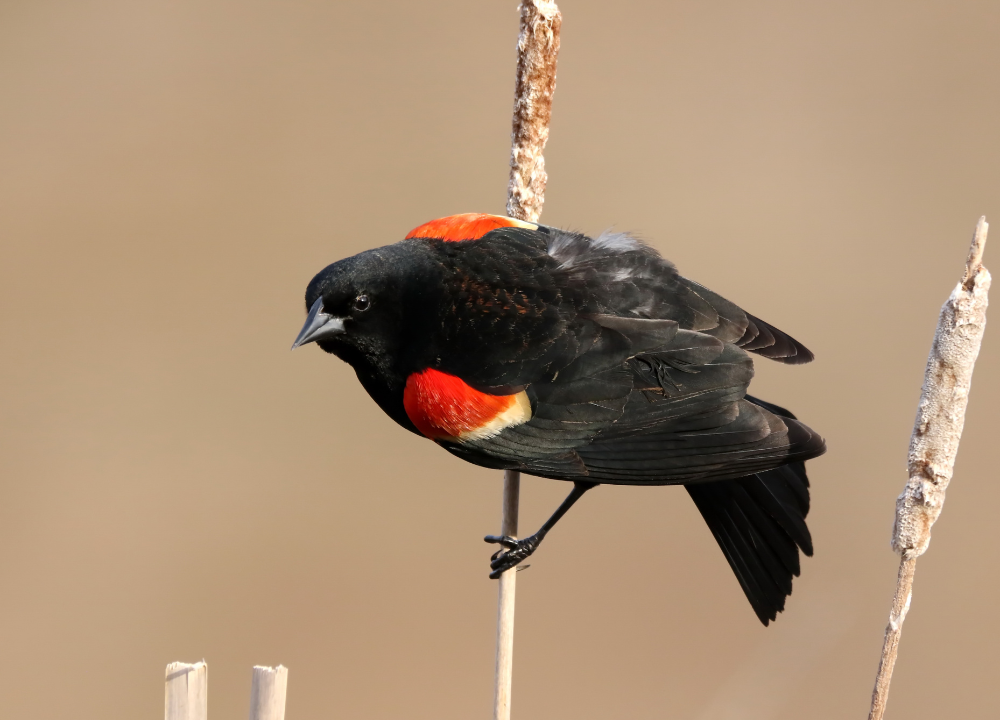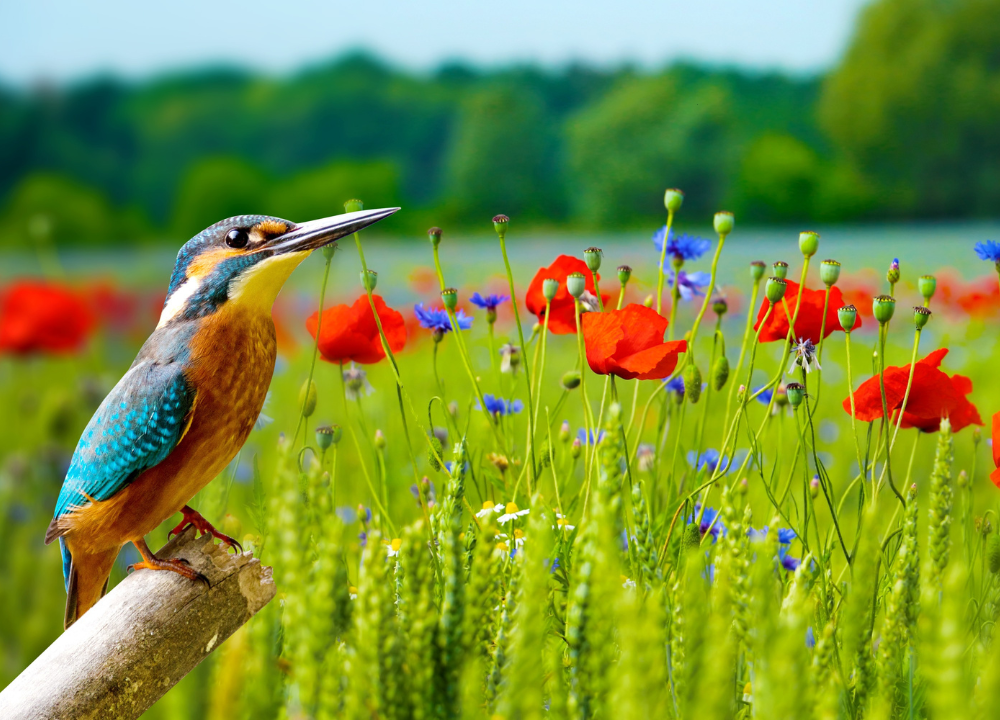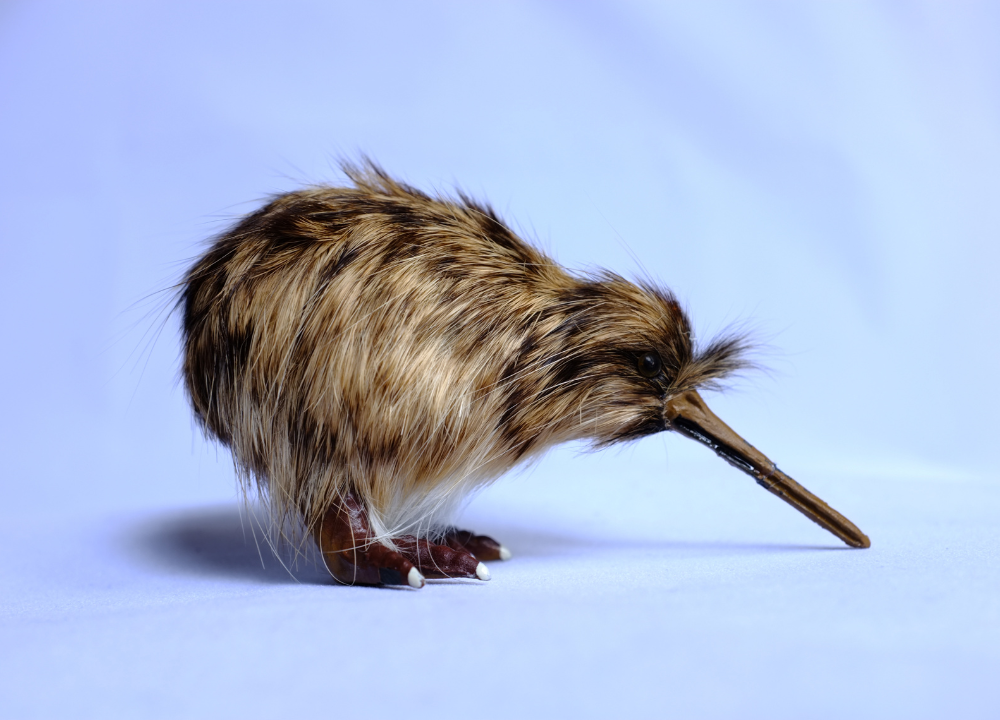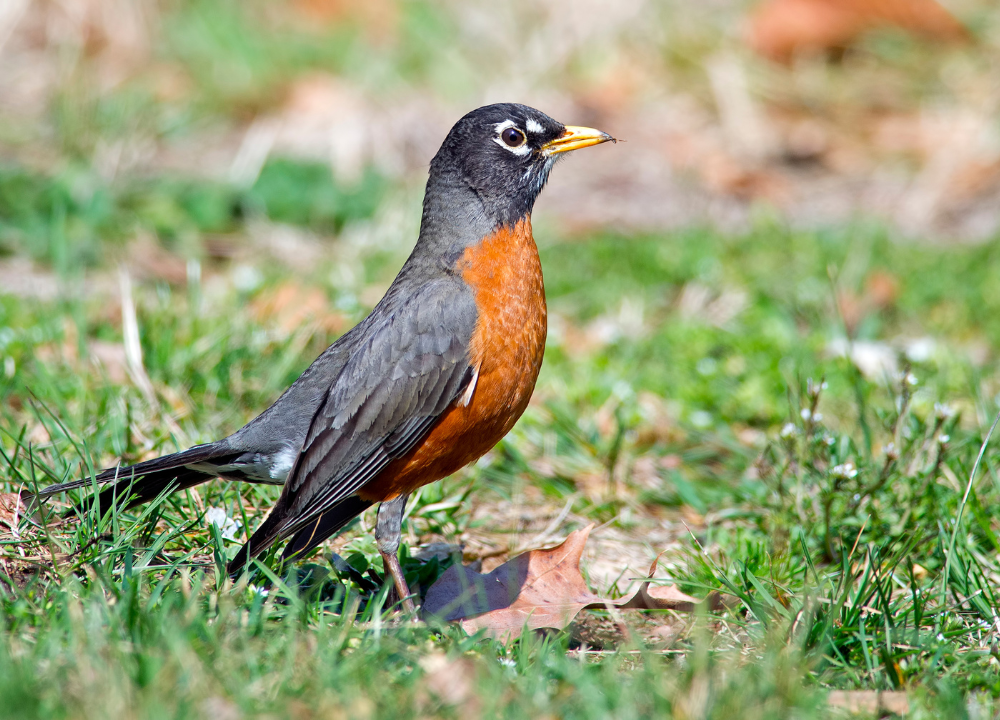The Black Bird with Orange Wings, often known as the Baltimore Oriole, showcases a striking color contrast. This bird is renowned for its vibrant plumage and melodious song.
Exploring the world of ornithology reveals a plethora of fascinating species, yet the Baltimore Oriole stands out for its unique beauty and behavior. With its black body and vivid orange wings, this bird not only captivates bird watchers but also plays a vital role in the ecosystem.
Appearance Of Black Bird With Orange Wings
The black bird with orange wings is a stunning sight to behold. It stands out with its striking contrast of colors. Nature has crafted this bird with a unique palette, making it a visual treat. Observing the appearance of this bird is like looking at a live painting. Let’s delve into the fascinating aspects of its looks.
Distinctive Features
The black bird with orange wings, often known as the Blackburnian Warbler or the Red-winged Blackbird, depending on the species, boasts features that catch the eye. Here are some key highlights:
- Size: Typically, these birds are of a medium size, with a compact and sturdy body.
- Beak: They present a sharp, pointed beak ideal for their insectivorous diet.
- Plumage: The plumage varies with the season, especially for males. It can range from muted to vibrant.
These birds have a distinctive appearance that includes:
| Feature | Description |
|---|---|
| Eye color | A deep brown that contrasts with their plumage. |
| Tail | Often fanned out, showcasing the orange and black colors. |
| Flight | Displays a unique undulating pattern, adding to their allure. |
Color Of The Wings
The color of the wings on these black birds is not just a simple orange. It’s a vibrant, fiery hue that captures attention. It can range from a deep, burnt orange to a bright, almost neon shade. This coloration serves multiple purposes:
- Attraction: Bright wings help attract mates during the breeding season.
- Camouflage: In certain habitats, the orange blends with the foliage, aiding in hiding from predators.
- Display: They often flash their wings to communicate and establish dominance.
Below is a table describing the variations in wing coloration among different species:
| Species | Wing Color | Seasonal Change |
|---|---|---|
| Blackburnian Warbler | Bright Orange Patches | More vivid in Spring and Summer |
| Red-winged Blackbird | Scarlet with a Yellow Stripe | Consistent Year-Round |
| Baltimore Oriole | Golden Orange | Brightest during Mating Season |
Habitat Of The Black Bird With Orange Wings
The Black Bird with Orange Wings is a breathtaking creature that captures the eye with its vivid colors. Often found flitting through their natural homes, these birds showcase a stunning contrast of darkness with a splash of fiery orange. Their habitat is as interesting as their appearance. It plays a crucial role in their life cycle, mating habits, and survival.
Geographical Range
The geographical spread of the Black Bird with Orange Wings is quite extensive. These birds are not bound to one location and thrive across different landscapes. Here are some key points about their range:
- Present in multiple continents, adapting to various climates
- Common sightings occur in North America, especially during migration seasons
- Parts of Europe also host these birds, with some residing year-round
Their distribution can be summarized in the following table:
| Region | Presence |
|---|---|
| North America | Seasonal |
| Europe | Year-Round / Seasonal |
| Asia | Less Common |
Preferred Environment
The Black Bird with Orange Wings is not just any bird; it has unique preferences for its home. This bird loves spaces where it can soar and sing. Let’s explore these preferences:
- Woodlands and forests are their top picks for nesting and feeding
- Grassy fields and open areas provide excellent spots for hunting insects
- Proximity to water bodies is important for their hydration and bath habits
These birds create their haven in environments that offer safety and food. They prefer places away from predators and close to nature’s bounty. Below is a glimpse of their favorite spots:
| Environment Type | Reason for Preference |
|---|---|
| Forests | Nesting and Protection |
| Fields | Feeding and Foraging |
| Wetlands | Water Source |
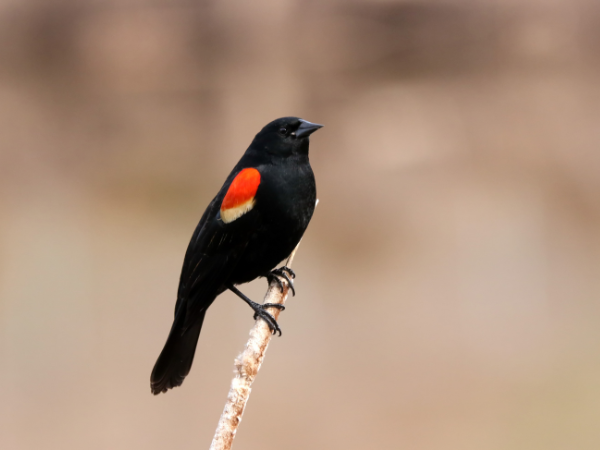
Diet Of The Black Bird With Orange Wings
The Black Bird with Orange Wings captures our imagination with its vibrant plumage. These birds boast a striking contrast between their dark bodies and fiery wing patches. Their diet is fascinating, revealing much about their lifestyle and survival strategies in the wild. Let’s delve into what these remarkable birds eat and how they find their food.
Food Preferences
The diet of the Black Bird with Orange Wings is both varied and interesting. It consists mainly of:
- Insects: such as beetles, ants, and caterpillars.
- Fruits: including berries and small fruits from bushes.
- Seeds: they enjoy a variety of seeds from different plants.
This bird’s eating habits change with the seasons. During spring and summer, insects make up a larger part of the diet. This is when protein is crucial for breeding and raising young. In the fall and winter, fruits and seeds become more important. These provide energy and help the birds stay warm.
| Season | Main Food Source |
|---|---|
| Spring/Summer | Insects |
| Fall/Winter | Fruits and Seeds |
Young birds are fed protein-rich insects to support their rapid growth. Adult birds adapt their diet to the available food sources, showing incredible versatility.
Feeding Behavior
The Black Bird with Orange Wings shows unique ways of finding and eating food. They display the following behaviors:
- Foraging: They search for insects by flipping leaves and digging in soil.
- Hawking: Sometimes, they catch insects mid-air in a swift, acrobatic move.
- Gleaning: They pick off insects and fruits directly from branches.
These birds are not shy about where they find their food. They forage in trees, on the ground, and even among plants. They are often seen hopping along the ground, their bright wings flashing as they look for food. In groups, these birds can cover more ground and find food more efficiently. This social behavior also provides safety in numbers.
When food is plentiful, the Black Bird with Orange Wings may store food for later. They hide seeds and insects in crevices or under leaves. This behavior ensures they have a food supply when resources are scarce.
Understanding the diet and feeding behavior of the Black Bird with Orange Wings gives us a glimpse into their daily lives. These birds are skilled survivors, adapting their diet to the changing seasons and available resources.
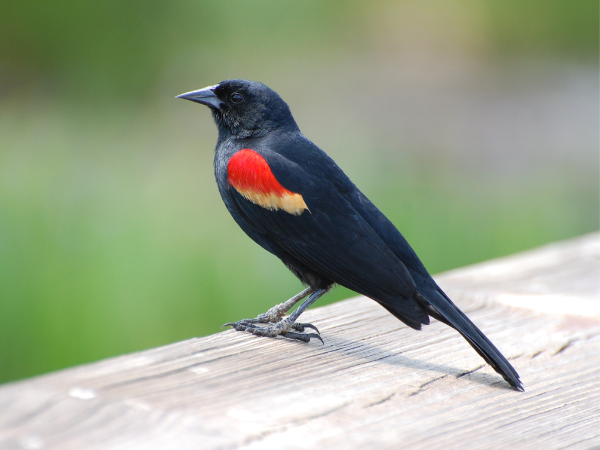
Behavior Of The Black Bird With Orange Wings
The black bird with orange wings is a stunning creature, captivating birdwatchers with its vibrant plumage and unique behavior. Exploring its habits offers a glimpse into the complex world of avian social structures and mating practices. The behavior of these birds reveals an intricate dance of communication and interaction that is both fascinating and instructive.
Courtship Rituals
Dating in the bird world is a visual and vocal affair, especially for the black bird with orange wings. During the breeding season, males flaunt their fiery wing patches to attract females. Here’s a peek into their courtship behavior:
- Dazzling Displays: Males spread their wings to showcase the orange blaze against their glossy black feathers.
- Serades: They sing complex tunes that echo through the forest canopy.
- Gift Giving: Some may present food items to woo their potential mates.
The table below summarizes the stages of their courtship rituals:
| Stage | Description |
|---|---|
| Attraction | Males display vibrant wings and sing. |
| Interaction | Couples engage in mutual preening and share food. |
| Nest Building | Females assess the nest sites males offer. |
Social Habits
The black bird with orange wings is also known for its complex social habits. These birds live in groups, or flocks, and have a clear social structure. Here are some fascinating aspects of their social life:
- Community Living: Flocks provide safety in numbers, helping each bird stay safe from predators.
- Foraging Groups: They often seek food as a team, using clever strategies to find the best treats.
- Communication: Their calls and songs keep the flock in sync, whether to alert danger or to bond.
Their social structure can be outlined as follows:
- Leaders: Certain birds guide the flock, often leading them to new feeding grounds.
- Watchers: Some members keep an eye out for threats, warning the group with specific calls.
- Nurturers: Adult birds care for the young, teaching them essential survival skills.
Migration Of The Black Bird With Orange Wings
The black bird with orange wings is a sight to behold. Each year, these vibrant creatures embark on a remarkable journey. They move across regions with the changing seasons. This migration is vital for their survival. It ensures they live in optimal conditions throughout the year. Let’s discover the secrets behind their seasonal travels.
Seasonal Movements
The black bird with orange wings experiences seasonal movements that are both fascinating and complex. These birds are not just casual travelers; they have a clear purpose for their journeys. As the climate changes, they seek out the best environments for feeding and breeding. Here’s a closer look at their seasonal movements:
- Spring: As winter ends, these birds head north. They seek out places rich in food to prepare for the breeding season.
- Summer: The birds settle in breeding areas. They choose spots with plenty of insects and fruits.
- Fall: With colder weather approaching, the birds move south again. They look for warmer areas with abundant food sources.
- Winter: The birds spend winter in milder climates. They stay until it’s time to head north again.
These seasonal movements are not random. They are crucial for the birds to thrive. The table below shows the typical habitats during their migration:
| Season | Habitat |
|---|---|
| Spring | Forests and woodlands |
| Summer | Nesting areas near water sources |
| Fall | Open fields and grasslands |
| Winter | Coastal regions and wetlands |
Migration Patterns
The migration patterns of the black bird with orange wings are a marvel of nature. These patterns are not the same for every bird. Some factors influence their migration. Here are key points about their migration patterns:
- Distance: Some birds travel thousands of miles. Others might move only a short distance from their breeding grounds.
- Timing: Birds leave at different times. It depends on the weather and food availability.
- Route: They often follow the same paths each year. These routes take advantage of wind patterns and stopovers with plenty of food.
- Social Behavior: Some birds migrate in groups. Others prefer to travel alone or with their mate.
These patterns ensure they find the best conditions for survival. Many factors can affect their migration. These include climate change, habitat loss, and food availability. Scientists study these patterns to help protect these amazing birds. The table below outlines the general migration patterns:
| Factor | Influence on Migration |
|---|---|
| Distance | Varies from short to long-range migrations |
| Timing | Depends on environmental cues |
| Route | Fixed paths with known stopovers |
| Social Behavior | Group travel or solitary flights |
Frequently Asked Questions
What Species Is A Black Bird With Orange Wings?
The black bird with orange wings is commonly known as the Baltimore Oriole. This bird is known for its vivid orange and black plumage and is a member of the Icteridae family.
Where Can You Find Black Birds With Orange Wings?
Black birds with orange wings, or Baltimore Orioles, can be found in eastern and central North America. They often inhabit open woodlands, gardens, and parks, especially during their breeding season.
What Do Black Birds With Orange Wings Eat?
Baltimore Orioles, the black birds with orange wings, primarily feed on insects, fruits, and nectar. Their diet includes beetles, caterpillars, and berries, which they forage in trees and shrubs.
How To Attract Black Birds With Orange Wings?
To attract Baltimore Orioles, offer foods like orange slices, jelly, or nectar. Installing oriole feeders and providing nesting materials like fibers can also entice these birds to visit your yard.
